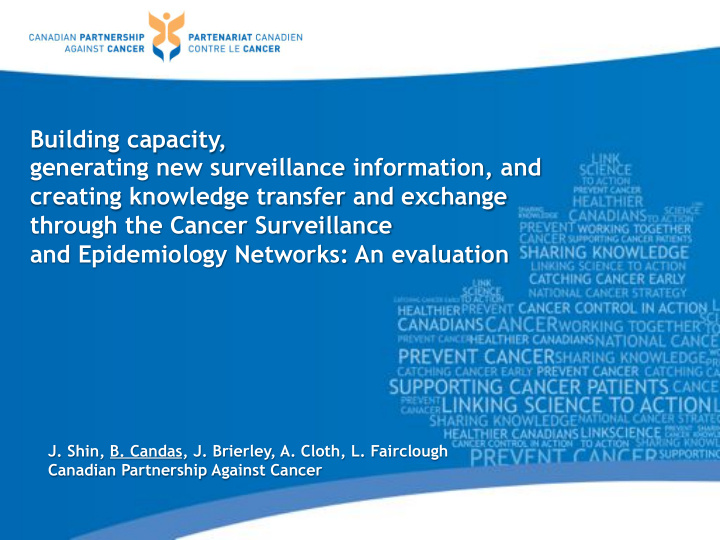



Building capacity, generating new surveillance information, and creating knowledge transfer and exchange through the Cancer Surveillance and Epidemiology Networks: An evaluation J. Shin, B. Candas, J. Brierley, A. Cloth, L. Fairclough Canadian Partnership Against Cancer
Cancer Surveillance and Epidemiology Networks CSPAN : Cancer Survival and Prevalence Analytic Network Dr. D. Turner, CCM CProj : Cancer Projection To provide national, regional, cancer site specific survival Network and prevalence estimates Dr. J. Hatcher, AHS To provide cancer site specific CRCNet : Colorectal short- and long-term estimates Cancer Network of future cancer burden Dr. L. Marrett, CCO To provide surveillance information HPEOL across the continuum of CRC, from risk factors to survival CProj CRCNet CProj CSPAN CSPAN CProj CRCNet HPEOL : Hospice Palliative CProj CRCNet CSPAN CProj CSPAN CRCNet End-of-Life Care CRCNet HPEOL CSPAN CSPAN HPEOL Surveillance Network CProj CRCNet CSPAN CSPAN Dr. F . Lau, Uvic CRCNet CRCNet HPEOL To provide surveillance information on terminally ill Italic: Participation limited to one health region Network : Core team location cancer patients and patterns of resources utilization
Evaluation of the CSEN Initiative PURPOSE: To assess the effectiveness and scientific quality of the CSEN initiative ! 1. Over the full life-cycle of the initiative ! • Program design and delivery • Performance (implementation and outcomes) 2. Achievement of the three objectives 1. Generate new knowledge 2. Develop analytic capacity 3. Implement Knowledge Translation and Exchange 3. Identify lessons learned: • Draw recommendations for further development of similar programs • Assess continued relevance and sustainability 3
Lessons learned and recommendations • Surveillance and data users community acknowledge that the progresses made by the Networks (notably in building analytic capacity) wouldn’t have happened without such a program • The need for Canada to grant access to national and provincial relevant data to the surveillance community remains critical to produce adequate and timely analysis • Effectiveness could be enhanced by involving all key national and provincial players in a single Network charged with developing the long term vision, medium term priorities and short-term plans. Such single Network would gather the surveillance, academic, cancer control, and KTE experts and representatives • Successful knowledge translation will require a more fully articulated KTE approach developed to increase participation and engagement of policy and program planners in cancer • Such a structure could harmonize and standardize relationships between the pan- Canadian cancer surveillance community and key national organizations Ongoing relevance and sustainability • A network-based model is strongly endorsed by the Canadian cancer surveillance community, as well as by policy program planners in cancer control across jurisdictions and organizations 4
Recommend
More recommend